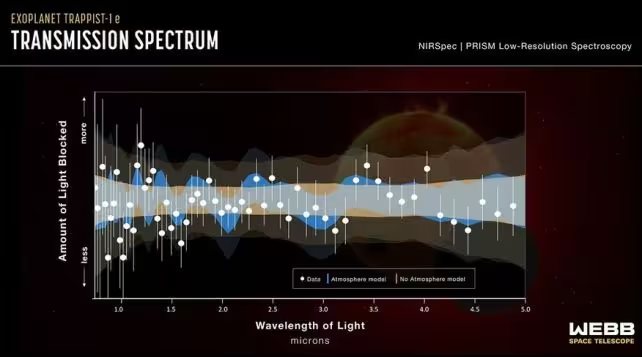6 Minutes
New JWST observations probe the atmosphere of TRAPPIST-1e
Scientists led by researcher K. Glidden and collaborators have taken the first steps toward identifying the composition of any atmosphere around TRAPPIST-1e, an Earth-sized exoplanet about 40 light-years away. Using transmission spectroscopy from the James Webb Space Telescope (JWST), the team analyzed starlight filtered through the planet’s limb during transits to search for telltale absorption and emission features produced by atoms and molecules in a planetary atmosphere.
How transmission spectroscopy reveals atmospheric gases
As stellar photons pass through a planet’s atmosphere, certain wavelengths are selectively absorbed and re-emitted by atmospheric constituents. On a recorded spectrum, these interactions appear as bands of relative dimming or brightening at specific wavelengths. By comparing the depths and shapes of these spectral features to models for gases such as carbon dioxide (CO2), methane (CH4), water vapor (H2O), molecular nitrogen (N2), and isotopic variants like deuterium-bearing species, researchers can infer the likely mixture of gases shaping the atmosphere.

Key findings: nitrogen-favored spectrum, low CO2 and deuterium scenarios unlikely
The JWST data analyzed so far disfavor a dense, CO2-dominated atmosphere similar to Venus or the thin CO2-rich atmosphere of Mars. The observations also argue against an atmosphere dominated by deuterium-rich hydrogen along with strong CO2 and methane signatures. Instead, the transmission spectrum is most consistent with a composition dominated by molecular nitrogen (N2), with trace amounts of carbon dioxide and methane.
This result is notable because Earth’s atmosphere is roughly 78 percent molecular nitrogen. If later observations confirm these initial detections, TRAPPIST-1e could stand as the most Earth-like exoplanet discovered to date in terms of bulk atmospheric composition. However, the current conclusion carries uncertainty: the signal is subtle and model-dependent, and additional JWST observations are already planned to validate or rule out the presence of an atmosphere.
What makes this result tantalizing but tentative
- Molecular nitrogen is spectrally quiet at many wavelengths, making it harder to detect directly than molecules with strong absorption bands (like CO2 or CH4). The inference of an N2-rich atmosphere therefore relies on the lack of strong signatures expected from other compositions and on subtle continuum effects.
- Trace CO2 and methane could still be present at levels consistent with the observed spectrum; their detection requires higher signal-to-noise and broader wavelength coverage.
- Stellar activity and instrumental systematics can complicate the interpretation of small spectral features; confirming the result requires repeat transits and complementary analyses.

Scientific context, mission details and implications
TRAPPIST-1e is one of seven planets orbiting an ultracool dwarf star in the TRAPPIST-1 system. Its size and temperate orbit placed it among the most promising targets for atmospheric characterization with JWST. Transmission spectroscopy with JWST’s high sensitivity in the infrared makes it possible to probe the atmospheres of small, rocky worlds for the first time.
The research from Glidden and colleagues appears in two companion papers in The Astrophysical Journal Letters. Their approach combines detailed spectral retrievals and comparative modeling to test scenarios ranging from hydrogen-dominated envelopes to nitrogen-rich, secondary atmospheres more analogous to Earth.

If validated, an N2-dominated atmosphere on TRAPPIST-1e would have major implications for exoplanet habitability studies. Molecular nitrogen acts as a background gas that influences surface pressure and climate, enabling surface liquid water under the right conditions. Detecting N2 indirectly therefore helps refine estimates of surface conditions and the planet’s potential to host life as we know it.
Expert Insight
Dr. Elena Morales, an astrophysicist specializing in exoplanet atmospheres, comments: "Detection of a nitrogen-dominated atmosphere on an Earth-sized world would be a milestone. N2 itself is hard to see, so this result, if confirmed, shows how powerful combined JWST observations and careful modeling can be. The next JWST program cycles will be decisive — they will either reinforce this picture or reveal a different composition."
Dr. Morales adds that advancements in retrieval techniques and cross-instrument calibration will be essential to separate planetary signals from stellar variability and instrument noise. "We are entering a phase where robust statistical validation of atmospheres will be just as important as initial detections," she says.
Future prospects and next steps
More JWST observing time has been allocated to TRAPPIST-1e and its sibling planets. Upcoming transit observations will extend wavelength coverage, increase signal-to-noise, and test alternative atmospheric compositions. Ground-based follow-up and parallel modeling efforts will refine estimates of possible surface pressures and temperatures.
In the longer term, combined measurements of atmospheric composition, surface conditions, and potential biosignature gases will be necessary to assess habitability. Instruments planned for future missions, alongside JWST, will expand spectral coverage and sensitivity to help disentangle complex atmospheric chemistry on small exoplanets.
Conclusion
Early JWST transmission spectra of TRAPPIST-1e favor an atmosphere dominated by molecular nitrogen with modest traces of carbon dioxide and methane, while ruling out strongly CO2-dominated or deuterium-rich hydrogen scenarios. The finding is provisional but significant: if confirmed, TRAPPIST-1e could be the most Earth-like exoplanet characterized so far. Additional JWST observations and rigorous modeling are already underway and will determine whether this nearby terrestrial world indeed hosts a nitrogen-rich atmosphere that could support temperate surface conditions.
Source: sciencealert


Leave a Comment